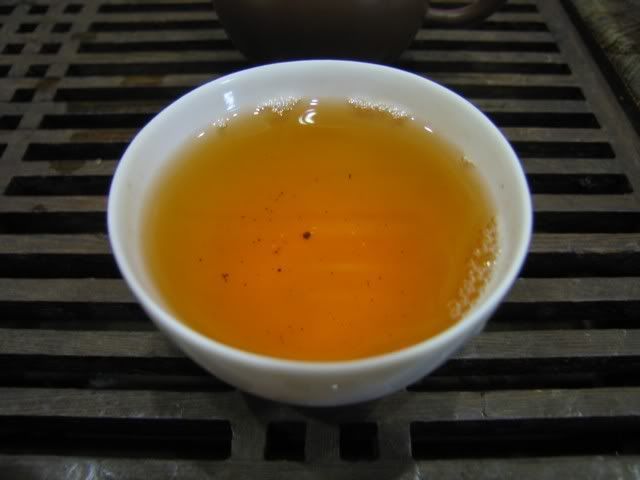Some of you may have heard of a practice called “xingcha” 醒茶, or “awakening a tea”. Generally this refers to letting an older cake of puerh come to life before drinking it. Everybody has a different routine, but it generally involves taking the cake out, perhaps breaking it up into pieces, air it out a little, put it in a jar, let it sit for a while, before actually drinking it. This process is supposed to improve the tea’s taste — it will be better than if you dive into it right away.
One can do this with loose puerh too, because I’ve talked to an owner of an old teashop in Hong Kong who said I should spread the stuff out on a plate or something, let it air out for a little, before drinking his tea. It will be smoother and better. Since last time I tried the loose tea I bought from Off-Chaism did not produce a good result, I decided I’ll do this to the bag of tea. I had a feeling that between the air-tight seal and the little pouch of anti-oxidation stuff they put in the bag (keeps oxygen out of the bag, I guess — I don’t know why they did this for a puerh) did the tea in, causing it to taste worse than it did at the store. I shook the tea around in the bag from time to time, and just generally let it air, hoping it will make the tea get better.
So I decided to give it another spin today.
Still the big leaves

Still the same colour

But I am happy to report that after a few infusions, it became obvious that the tea is, indeed, better. It is noticeably less rough than the last time I tried the tea, which was one of my complaints. It also wasn’t as sharp on the tongue or as obviously bitter (though it was definitely still there). Instead, the tea acquired a little more aromatics. Much more pleasant to drink this time around. Obviously a dry stored tea still, but it is a Taiwan dry stored one — not the driest of dry, with just enough aging to give it that aged taste.
Which makes me wonder even more — why did they pack this tea they way they did? I guess they mostly sell oolongs, so there’s a need to pack it well. But…. this isn’t an oolong. Given all the packaging materials that went into the box, you’d think they can take enough care to package it the way it should be — maybe with a little less care so the tea doesn’t taste nasty out of the box.
The tea held up quite well for many infusions. This is a later one… probably 12?

The leaves are still the same, of course — a mixed bag.

I’m happier with this purchase now, although I’m still not sure if it’s worth the price. I suppose though, for a dry stored tea with obvious aging… it’s not so bad.

5 responses so far ↓
lewperin // October 19, 2007 at 3:01 pm |
[…]the little pouch of anti-oxidation stuff they put in the bag (keeps oxygen out of the bag, I guess — I don’t know why they did this for a puerh)
Hmm, I haven’t heard of this. Are you sure the pouch didn’t contain a desiccant?
But that isn’t the main point. I’d been following the xing cha advice for a while (without knowing its name!) but hadn’t thought to validate it with a comparison. Thanks for this!
MANDARINstea // October 19, 2007 at 6:00 pm |
Tea suffer jet-lag also. If you brew them right after a plane ride, they are nasty!
-T
Anonymous // October 19, 2007 at 8:43 pm |
Lx, thx for the Chinese term. I grew up it was “Air it out†“Let it breath a wee bit†In my book a must with Pu-erh. I also do it with most teas, Oolongs just a short time before brewing. I taste the bigger difference with teas that are cold stored. … john
MarshalN // October 19, 2007 at 11:41 pm |
I think cold stored teas are nasty.
The little packet says “oxygen absorber”….. whatever that is 🙂
Phyllo // June 2, 2008 at 9:01 pm |
“Tea suffer jet-lag also. If you brew them right after a plane ride, they are nasty!”
As do wines.